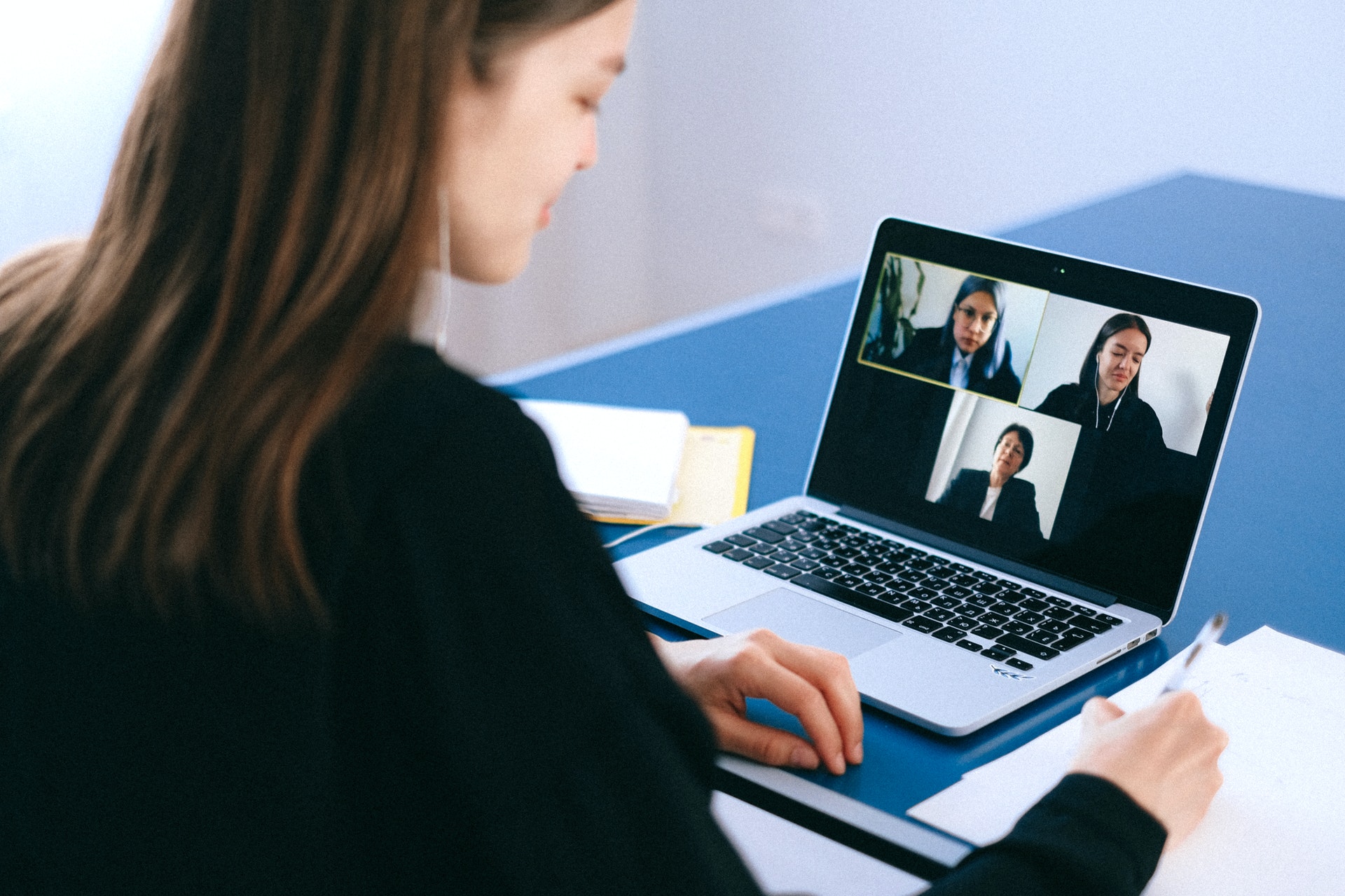
Hello? Can You Feel Me Now?
Virtual Connections and Workplace Engagement in the Current Wave of COVID
by Lara Otte, PsyDFor those fortunate enough to keep their jobs and transition to working from home, the coronavirus pandemic has forced a worldwide experiment on the benefits and shortcomings of remote work. As time goes on, the data keeps rolling in as to the effects of this significant, and now ongoing, shift. Many important questions are being posed, including “What is necessary and valuable about our workplace?” At best, this moment is an invitation to redesign the workplace, to get rid of things that perhaps weren’t working in the first place and establish new structures and practices that will serve us into a new future.
This article will focus on the structures and issues arising in “knowledge workplaces,” or the “knowledge economy,” in which outcomes are built on the exchange of ideas, thoughts, insights, and the ability of groups of people to coordinate work around solid action plans. For these workplaces, being physically located in the same place is not a necessary condition for productivity. For the purposes of this article, the focus will be on the unfolding impact of using videoconferencing as a primary means of workplace communication and coordination.
At the beginning of lockdown, there was an acceleration in companies adopting digital collaboration tools, and newly remote teams began using video as a default. As a result of this agility, productivity has largely been maintained, and in some cases improved. From this angle, there is a general sense that the future of the workplace has been altered in a positive direction and large tech companies like Twitter, Square and Facebook have agreed to make remote work a permanent option.

As the WFH situation becomes prolonged, however, there is also increasing awareness of the longer-term downsides of remote work. There is talk of Zoom fatigue, the drained feeling that comes from having to exert extra energy to compensate for the lack of social cues (facial expressions, tone, pitch, gestures, body positions) that we naturally benefit from in in-person interactions. In addition, people are generally working more hours, the blurring of work time and personal time creating an unsustainable imbalance. With productivity concerns at least temporarily abated, greater attention is now being paid to the long-term ability of teams to stay engaged, creative and innovative at a physical distance. A recent analysis by Cushman & Wakefield stated, “Human connection and social bonding are suffering, impacting connection to corporate culture and learning.”
In a recent HBR article, Scott Berinato writes, “We humans naturally absorb a great amount of information about our environment and each other, including nonverbal cues, when we are interacting in the physical world. This improves communication, trust, and performance with team members and allows us to establish and cultivate richer working relationships, increasing the value of human work altogether.” Research has shown that there is less small talk and “schmoozing” (an exchange of personal information that helps establish rapport) among virtual workers, which diminishes trust. As pointed out in another recent HBR article, “the decline in such spontaneous communications and trust can have a big negative impact on innovation and collaboration.”
The leadership development literature often points to the responsibility of leaders to create an atmosphere of trust and belonging. While this is certainly important, team members also contribute to this atmosphere with their own unspoken moods, participation (or lack thereof) and contributions of specific thoughts, feelings and opinions. In a physical workplace, there is a large stream of information that helps individuals and teams build a cognitive map of the moods, concerns, interests, and desires of other individuals and groups within the organization. Chance encounters are opportunities for cross-team visibility, which strengthens social networks and improves performance. Moreover, these are moments to experience a sense of belonging and place in the greater structure, which fosters employee engagement. It follows that a narrowing of such input from a physical work environment, over time, can create a breakdown in engagement and trust. If workers are normally able to survey a broad landscape of social input, remote work is more analogous to looking through a keyhole—or many successive keyholes—offering more narrow streams of information that make it harder to hold in mind the bigger picture. Pre-COVID research on virtual teams underlines the challenges of remote work in terms of maintaining communication and psychological engagement.
So, where do we go from here? First, we should congratulate ourselves for the initial adaptation. We got the mechanics of WFH down without missing a beat! However, we cannot mistake this momentary adjustment as a good enough or sustainable solution. The next wave of adaptation involves both a closer look at the nuanced and varied impact of extensive amounts of videoconferencing (and careful attention to how we mitigate its negative effects), as well as an appreciation of the ongoingness of this very human challenge.
It makes sense that the more operational aspects of working at a physical distance were easier to identify and compensate for than the more subtle emotional and interpersonal aspects of remote work. It is much more difficult to operationalize unplanned interactions and the nuances of human connection that occur in physical space, much less to implement them in remote work environments. One article suggests we decrease psychological distance by humanizing our interactions with colleagues; for example, hosting virtual coffee breaks or lunches, scheduling meetings with open agendas or for the sole purpose of being social (happy hours, online games), or creating a buddy system to connect colleagues outside of work hours.
When formal, calendared events make up almost the entirety of our daily professional communication, it is easy to drift toward a more transactional way of being. The absence of possibility for spontaneous connection (a glance across the table at a meeting, a joke in the hallway on the way to the next one, joining the stream of coworkers headed to lunch) can both promote efficiency (less distraction) and disengagement. The distance from situations that are anxious, intense or annoying is a kind of relief, yet, at the same time, we can feel like we are walking around in a monochromatic version of our formerly colorful professional lives. For instance, how do we each process the moment when an energetic meeting ends and our screen goes blank?
While there are no easy or definitive rules, experts are weighing in with some best practices for onboarding new employees, maintaining existing connections, optimizing virtual meetings, and deciding which technology to use in which situations. A recent article by Amy Edmonson and Gene Daley says, “The good news is that the very technology that thwarts candor and mutual understanding also offers ways to offset those losses.” It is absolutely critical to become familiar with and apply these best practices. However, there is a limit to how much virtual lunches, Slack channels, good lighting, anonymous polls, and breakout rooms will solve these challenges of human connection.

Last week I asked a coaching client, the CEO of a small tech startup that switched to fully remote work in March, whether there had been any recent discussion of work from home and how people are feeling about it at this point. He said there hadn’t been, and when he brought it to the leadership team, there was some initial hesitation to share their personal experiences. The underlying, and not uncommon, sentiment was “We’ve made the transition, it’s working okay, what else is there to talk about?”
Alternately, I hear from leaders who are expressing dissatisfaction, “I just don’t feel like people are showing up the way they used to!” But, scratching the surface, what often emerges is a leader’s own disappointment and grief around the loss of richness in their day-to-day connections. One leader told me, “The meeting ends and then it’s just nothing. No drink or dinner to unwind. Not even a chat with someone on the way to my car. It’s just… over.”
At the very beginning of lockdown, Scott Berinato published an oft-quoted article for HBR, “That Discomfort You’re Feeling is Grief”. In collaboration with David Kessler, a leading expert on grief, he underlines the power of naming and normalizing the collective experience. Once observed and spoken about, we unlock the ability to manage and take action around a situation, structure or experience. In addition, the nature of grief is non-linear, meaning we do not move through it in neat, successive stages. Finally, and perhaps most importantly for the current moment, grief is not a “one and done” phenomenon. It comes in waves, multiple times over, particularly in a situation like the pandemic where the outcome is yet unknown.

The awareness that we are in recurring waves of grief runs counter to the expectation that we should be operating and feeling engaged “like normal.” Like any breakdown, it is disruptive and uncomfortable, and parts of us would prefer to “move on.” We will undoubtedly shift and adapt as we move through this uncertain time, but what about the long-term cost to human connection and workplace engagement? Will we just wait for the light at the end of the tunnel (a vaccine, perhaps) to shift us out of Zoom Doom? Beyond our seemingly intact productivity, what do we need right now to combat the drift into transactional mode and stay engaged with our teams and creative in our work?
There are more questions than answers at this point. Perhaps what people need most is the ongoing opportunity to observe and share their emerging experiences and insights. In doing so, we keep our connections real and alive, and potentially illuminate some new paths forward. With that, I leave you with the following questions: How is operating “like normal” showing up in your work? What aspects of work are producing the most satisfaction for you right now? The most dissatisfaction? What keeps you from sharing your experiences with colleagues? What would make the biggest difference for your workplace engagement today?
I will be asking these questions of the leaders I work with in the coming weeks and months, and publishing a follow on to this article. In the meantime, I invite you to share your reflections in the comments.
— Published on September 14, 2020